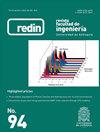Cr(VI)的生物吸附:温度、粒度和床层高度的影响
IF 0.5
Q3 ENGINEERING, MULTIDISCIPLINARY
Revista Facultad De Ingenieria-universidad De Antioquia
Pub Date : 2020-02-21
DOI:10.17533/udea.redin.20191149
引用次数: 5
摘要
研究了温度、粒径和床层高度对大车前草皮连续吸附六价铬的影响。实验在填充床柱上进行,通过连接K型热电偶的REX-C100控制器调节溶液的进料温度。Cr (VI)的初始浓度为100 ppm, pH为2,进料速率为0.75 mL/s。采用1.5-二苯脲比色法进行紫外可见光谱分析。利用傅里叶变换(FTIR)对材料进行了红外光谱表征,从分析中确定OH和NH2官能团是与溶液中阳离子形成配合物的主要原因。此外,还确定了只有粒径具有统计学意义。根据响应面分析,最佳工艺条件为353.15 K、粒径0.819 mm、床高67.768 mm。热力学研究表明,该过程为吸热过程,主要以化学吸附为主。在过程建模中获得的结果表明,剂量-反应可以可靠地用于扩展过程。本文章由计算机程序翻译,如有差异,请以英文原文为准。
Cr(VI) biosorption: Effect of temperature, particle size and bed height
The present work aimed to evaluate the effect of temperature, particle size and bed height of the chromium (VI) adsorption process using plantain peels in a continuous system. The experiment was carried out on a packed bed column, adjusting the feed temperature of the solution with a REX-C100 controller coupled to a type K thermocouple. The initial concentration of Cr (VI) was set at 100 ppm, the pH at 2 and the feed rate of 0.75 mL/s. The analyses were performed by UV-Vis spectroscopy using the colourimetric method of 1.5-diphenylcarbazide. The material was characterized by infrared spectrometry by Fourier Transforms (FTIR), from this analysis, it was determined that the OH and NH2 functional groups are the main responsible for the formation of complexes with the cations in solution. Also, it was established that only the particle size is statistically significant. According to the response surface analysis, the optimum conditions of the process were 353.15 K, a particle size of 0.819 mm and a bed height of 67.768 mm. From the thermodynamic study of the process, it is established that it is endothermic and the chemical adsorption prevails in it. The results obtained in the process modelling suggest that Dose-Response can be used reliably to scale the process.
求助全文
通过发布文献求助,成功后即可免费获取论文全文。
去求助
来源期刊
CiteScore
2.00
自引率
0.00%
发文量
27
审稿时长
2 months
期刊介绍:
Revista Facultad de Ingenieria started in 1984 and is a publication of the School of Engineering at the University of Antioquia.
The main objective of the journal is to promote and stimulate the publishing of national and international scientific research results. The journal publishes original articles, resulting from scientific research, experimental and or simulation studies in engineering sciences, technology, and similar disciplines (Electronics, Telecommunications, Bioengineering, Biotechnology, Electrical, Computer Science, Mechanical, Chemical, Environmental, Materials, Sanitary, Civil and Industrial Engineering).
In exceptional cases, the journal will publish insightful articles related to current important subjects, or revision articles representing a significant contribution to the contextualization of the state of the art in a known relevant topic. Case reports will only be published when those cases are related to studies in which the validity of a methodology is being proven for the first time, or when a significant contribution to the knowledge of an unexplored system can be proven.
All published articles have undergone a peer review process, carried out by experts recognized for their knowledge and contributions to the relevant field.
To adapt the Journal to international standards and to promote the visibility of the published articles; and therefore, to have a greater impact in the global academic community, after November 1st 2013, the journal will accept only manuscripts written in English for reviewing and publication.
Revista Facultad de Ingeniería –redin is entirely financed by University of Antioquia
Since 2015, every article accepted for publication in the journal is assigned a DOI number.

 求助内容:
求助内容: 应助结果提醒方式:
应助结果提醒方式:


